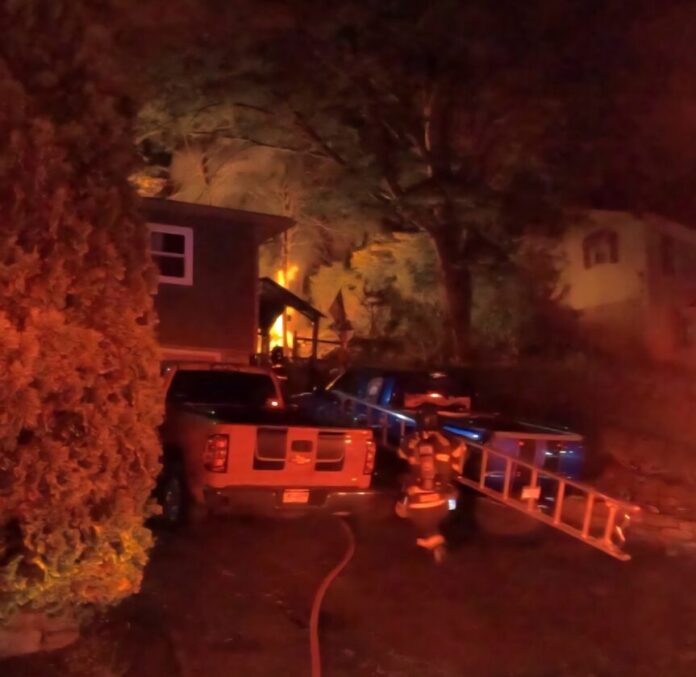On a quiet Sunday night in Williamsport, the crackle of flames broke the stillness. What began as a brush fire quickly spread to a small shed, sending firefighters racing down Southview Avenue just after 10 p.m. Within minutes, the fire that could have grown into something much worse was brought under control.
This latest fire update serves as both a reminder of how fast flames can move and a testament to the quick work of local crews.
The Incident: A Close Call in the Neighborhood
According to Williamsport fire officials, the blaze erupted behind 5 Southview Avenue, just west of the 1600 block of Hepburn Street, around 10:20 p.m. Sunday night. Neighbors spotted the flames climbing into the dark sky and dialed 911.
By the time firefighters arrived, the brush and a small storage shed were already burning. The scene could have escalated sheds often store fuel, tools, or flammable materials—but crews wasted no time.
Platoon Chief Sherman Heaster confirmed the fire was knocked down in just 15 minutes. No injuries were reported, and though the exact cause is still under investigation, residents can breathe a sigh of relief that it ended without tragedy.
If you’ve ever seen a fire flare up outdoors, you know how fast it can grow. One moment it looks manageable; the next, it’s racing through dry brush, fences, or sheds. That’s why every second counts, and on Sunday night, Williamsport’s firefighters proved once again why their speed matters.
A Night of Tension Turned Relief
Neighbors described the moment as tense—seeing flames so close to homes, with the worry that the fire could jump to nearby properties. For many, it was a reminder of just how fragile safety feels when fire enters the picture.
But just as quickly as the tension rose, relief set in. Within a quarter of an hour, crews had the fire under control. Hoses snaked across lawns, flashlights cut through smoke, and the smell of charred wood hung in the air. Yet, by midnight, the neighborhood was calm again.
Why This Fire Incident News Matters
At first glance, a brush and shed fire might not seem like a big deal compared to the larger blazes that make national headlines. But when you step back, the bigger picture is clear:
-
Fires start small before they get big.
-
Quick responses save homes, neighborhoods, and sometimes lives.
-
Every fire, no matter the size, carries lessons about prevention and preparedness.
This wasn’t just a shed lost. It was a moment where fast action stopped a chain reaction from unfolding.
Fire Safety Awareness: Lessons From the Williamsport Blaze
Every fire leaves behind questions, and this one is no different. The cause is still under investigation, but the circumstances highlight important safety reminders.
Here are a few key takeaways:
1. Brush Fires Spread Faster Than You Think
Dry leaves, weeds, and grass ignite easily. Even small sparks—like from a cigarette butt or backyard fire pit—can set them off. Keeping yards clear of dry brush is one of the easiest ways to reduce fire risk.
2. Sheds Can Be Fire Hazards
Sheds often house gasoline, paint, propane tanks, or tools with oil residue. If fire reaches these, flames intensify quickly. Storing flammable items in sealed containers and keeping sheds ventilated can make a big difference.
3. Every Second Counts
The Williamsport fire was under control in 15 minutes because neighbors acted fast and firefighters responded immediately. Early reporting is crucial. If you see smoke, don’t wait—call it in.
4. Nighttime Fires Add Risk
This blaze broke out around 10:20 p.m., when many families were winding down for the night. Fires at night can be especially dangerous because visibility is low and residents may be asleep. Outdoor motion lights and working smoke detectors in nearby structures add layers of protection.
The Role of Firefighters: Quick Action, Big Impact
If you’ve ever watched a firefighter run into a scene like this, you know it’s both impressive and humbling. In Williamsport, crews were racing with hoses, cutting off flames before they spread, and dousing hot spots so the fire wouldn’t reignite.
It’s easy to take these moments for granted—until you realize how different the outcome could’ve been if the fire had burned even a few minutes longer. This wasn’t just luck; it was training, teamwork, and commitment.
Community Responsibility: What Residents Can Do
Fire safety isn’t only about firefighters showing up when something goes wrong. It’s also about what we do as community members to reduce risks. Here are practical steps every household can consider after this latest fire update:
-
Clear brush and yard debris regularly. Don’t let piles of leaves or weeds accumulate near fences or sheds.
-
Check outdoor wiring. Faulty extension cords or exposed wires can spark fires in sheds or backyards.
-
Store chemicals safely. Gasoline, propane, and paint should be sealed tightly and kept away from direct heat sources.
-
Have a garden hose or fire extinguisher handy. In small fires, quick action before crews arrive can sometimes make a difference.
-
Know your address details. When calling 911, being able to give the exact location helps firefighters get there faster.
Fires in Small Structures: A Bigger Pattern
The Williamsport blaze is not an isolated case. Across the U.S., small fires in sheds, garages, or brush piles make up a significant portion of local fire calls. While they may not grab national headlines, they pose real risks—especially when close to homes or businesses.
According to fire safety experts, outdoor storage sheds are among the most overlooked fire hazards. Unlike homes, they rarely have smoke detectors or fire-resistant materials. Once ignited, they can collapse quickly, spreading flames to nearby property.
That’s why staying vigilant isn’t about fear—it’s about common-sense protection.
Why Fire Safety Awareness Should Be Year-Round
Many people associate fire danger with hot summer months, but fires don’t keep calendars. Even in September, when evenings cool, dry brush can ignite. And as heaters, fire pits, and candles come back into use during fall, risks shift from outdoor brush to indoor hazards.
The lesson? Fire safety awareness isn’t seasonal. It’s something communities need to practice year-round.
Looking Ahead: Investigation Continues
For now, investigators are working to determine the cause of the Williamsport blaze. Whether it was accidental or preventable, one fact is already clear: fast reporting and quick response kept a bad situation from turning tragic.
Residents are left with scorched brush, a damaged shed, and the smell of smoke lingering in the air. But they’re also left with gratitude—gratitude for firefighters who showed up in minutes, for neighbors who called it in right away, and for the fact that no lives were lost.
Why This Latest Fire Update Matters
So, what can we learn from this fire?
That no blaze is too small to take seriously. That every second matters. Prevention is always easier than recovery. And that behind every “minor” fire report, there’s a story of people whose night was shaken, whose safety was threatened, and whose relief was made possible by quick action.
Fire incident news like the Williamsport blaze might fade from headlines quickly, but the lessons linger. Fires don’t wait for daylight. They don’t wait for fire season. They don’t wait for us to be ready.
And that’s why fire safety—awareness, preparation, and vigilance—has to be part of our everyday lives.

